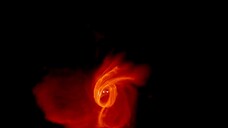Scientists have discovered the driver of photosynthesis that gives energy to plants, algae and some groups of bacteria, managing to piece together all the stages in the reaction that produces oxygen from water, transforming Earth's atmosphere two billion years ago.
The result, published in Nature, opens up new possibilities for producing clean energy using very common, low-cost materials that absorb light and generate electricity. Manganese, iron and nickel are among the possible candidates.
Italian researchers belonging to the Computational Chemistry group led by Leonardo Guidoni of the Department of Physical and Chemical Sciences at the University of L'Aquila performed the chemical simulations and supercomputer calculations needed to arrange all the pieces of the photosynthesis puzzle, with the participation of Matteo Capone and Daniele Narzi. Holger Dau's German group from the Freie Universität Berlin gathered the experimental data.
"In particular, we reconstructed the step in which an oxygen molecule is created from water," said Guidoni. The basic steps had been known for more than 50 years, "but there was still no chemical characterization of the last stage, the most difficult to grasp,” he explained. “We worked for ten years on this point, using high-performance computing to predict the evolution of the chemical reaction in all the steps,” concluded Guidoni.
The results pave the way for so-called artificial photosynthesis, used to identify synthetic materials that mimic photosynthesis to produce energy.
Riproduzione riservata © Copyright ANSA













